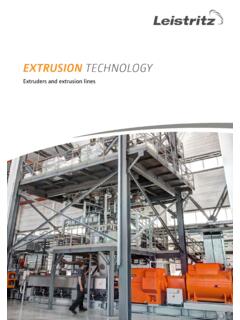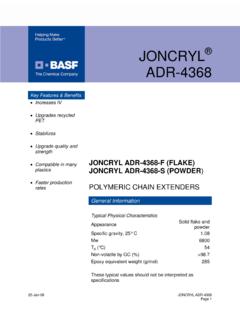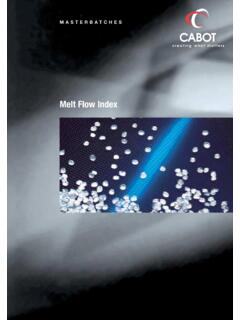Transcription of Introduction to rubber processing and safety issues
1 Introduction to rubber processing and safety issues This section provides details of the mechanical processes involved in the production of various types of rubber goods. Details are included of the various safety and fire and explosion hazards but there are only brief references made to the health risks. For information on health risks see health and safety topics. The industry uses very powerful machinery with the potential to cause fatal and serious injuries. There are established industry safeguarding standards for two-roll mills, internal mixers and calenders. Many serious accidents take place during repairs or to clear blockages etc. and there must be procedures in place to ensure that safe interventions take place. Contents Compounding (including powder handling, mixing and milling) Extrusion Calendering Cloth coating Fabrication (including tank lining, roller covering, and hose winding) Vulcanisation (including presses, autoclaves and continuous vulcanisation) Latex processing Polyurethanes (including PU foam production, reconstituted foam and conversion and rigid urethanes) Tyre building Tyre retreading Compounding - powder handling, mixing and milling Introduction Compounding involves the measuring and mixing together of raw rubber , process oils, carbon black, bulk fillers, and rubber chemicals in pre-determined proportions, termed formulations.
2 A rubber compounder can typically use between 100 and 200 different ingredients to mix a range of formulations. The finished mixture is known as compound and is the material that is processed into rubber articles by moulding, extrusion, calendering etc. Bale cutting Before being added to the mixer the rubber may need to be cut into small pieces on a bale cutter or guillotine. These are usually down stroking machines, which should be securely fenced with interlocking access gates. Feed openings/tunnels should also meet safety reach distances. The standard bale cutter is designed for bales. These are by far the most common machine but some of the larger old type shown below may still be in use. The standard bale can be fed directly into most larger rubber mixers but this small bale cutter is required to get the correct weight for the compound recipe. Carbon black storage handling area, bulk bagemptying. Note specialist HEPA vacuum for clean-up.
3 Standard bale cutter For larger machines, during maintenance or cleaning the blades should be supported, as shown below: Some older machines have a fixed knife and an up stroking moving table. These should have interlocking guards to prevent access to the cutting area. Also, the trap between the lower part of the moving table and the edge of the floor should be eliminated by safety fairings. Bale handling Most of the rubber industry use mechanical handling such as the vacuum bale lifter. These are a reliable and low cost option for handling the standard bales. Vacuum bale lifter Fire and explosion hazards Many of the rubber compounding additives are fire sensitive, particularly: Sulphurs and organic peroxides (used as curing agents); azodicarbonamide (used as a blowing agent in some open celled rubber /lattices). Particular care is required in storage areas to make sure incompatible materials, such as carbon black and sulphur, are adequately segregated.
4 There have been incidences of dust explosions in powder handling areas. Many rubber compounding additives such as azodicarbonamide, calcium and zinc stearates, are known to be highly explosive when in a finely divided state. Design dust extraction and collection systems for use with potentially explosive dusts. Good housekeeping will minimise the risk of secondary dust explosions. Mixing Once the compound ingredients have been weighed out they are mixed together using specialised machines capable of dealing with the high stresses involved in shearing rubber . Mixing can be either by internal mixing or external/open mill mixing which have very different safety problems. Internal mixing (eg. Banbury or Intermix mixers) The compound ingredients are fed into an enclosed mixing chamber via a feed hopper and mixed by the shearing action of two winged rotors and the walls of the mixing chamber. There is therefore a continuous nip. A powered ram or floating weight in the feed throat forces ingredients into the mixing chamber, which is usually water-cooled.
5 The mixed compound is discharged via a sliding or hinged door below the mixing chamber, usually onto a two- roll mill, roller die, twin - screw extruder, conveyor, skip hoist, or wheeled truck. Main mechanical hazards Feeding ingredients and collecting compound The principal dangers and safeguards on a Banbury type internal mixer are: The rotors, via the feed opening (contact with rotors or falling in on larger machines) These risks can be guarded against by feed tables or conveyors placed in front of the feed opening, with additional fixed side guards, where necessary. Safe reach distances should meet the requirements of Table 4 of BS EN ISO 13857: safety of machinery. safety distances to prevent hazard zones being reached by upper and lower limbs. The floating weight trap with the fixed bridge casting from either the feed opening or the rear inspection door. There should be sufficient clearance between the bridge and the fixed bridge casting to prevent a finger-trapping hazard.
6 Prevent access by using the same safeguards as for the rotors. The floating weight and the lower edge of the front hopper door at the feed opening. The trap at the bottom of the weight is more dangerous. Operators are at risk when sweeping down or when adding lubricant or other small ingredients. Where access to the trap is possible, interlock movement of the floating weight with the hopper door. The front hopper door and frame as the door closes and the stops as it opens under power Where powered movement of the door creates a trapping hazard, it's operation should be via a hold-to-run control, located out of reach of the door or a two-hand control on the hopper itself. A front feed table preventing access will also improve safety . Where bin-tipping units feed mixers, enclosing interlocking guards are required to prevent access to shear traps created by the tipping mechanism. Cleaning and maintenance The greatest hazard at internal mixers is during maintenance and cleaning, including, clearing of blockages.
7 Operators may need access to the mixing chamber/rotors, normally via the discharge opening. There is an incentive to do this quickly as the compound hardens as it cools and a possible temptation to take shortcuts. Maintenance staff are more likely to use the rear inspection door. A trapped key interlocking system is required at both the rear inspection and discharge openings. Because of the size of internal mixers, operators can be working at three levels: the rear inspection door on the feed platform; the discharge door at the motor platform; and the dump chute access at floor level. Communication is therefore difficult with the potential to increase risks. In addition, stored electrical, hydraulic and pneumatic energy as well as the potential energy from gravity fall of the floating weight and inertia from run down of the rotors, may be released if the correct run down procedures are not followed. A trapped key interlocking system on all access doors, including a time delay and scotching of the floating weight is one means of preventing access to widely separated danger areas and is the accepted industry standard.
8 The principle employed is that all sources of power are isolated and all stored energy is dissipated, before access is possible. For further information see safe interventions and BS EN 12013 rubber and plastics machines Internal mixers - safety requirements Interlocking is by means of a main key exchange box, as shown below. All isolating keys have to be inserted before any access key can be released. When a guard is open, it traps the access key in it; likewise, when a part controlled by an isolating key is live, the key remains trapped in it. For example, before the rear inspection door shown above can be unlocked and opened, the compressed air supply has to be locked shut; with both ends of the floating weight cylinder vented to atmosphere and the floating weight supported on a scotch pin, which is locked in position. In addition, the isolator for the main and hydraulic pump motors has to be locked open and the rotors have to be at rest.
9 This condition is achieved by a time delay unit that releases an isolating key for the main exchange box only after enough time has passed for the motor to come to rest. Access to the other hazardous parts is obtained by a similar process. Drop door maintenance position on Banbury mixer with castell key Access hatch to hopper on Banbury mixer and details of castell key Details of Banbury castell key systemExternal or open mill mixing (two roll mills) This refers to mixing operations using horizontal two roll mills. The operator (usually known as a mill man) places the various ingredients in the nip formed between the rolls and mixes the compound by cutting it off the rolls and re-feeding it into the nip until all the ingredients are added. Mills are used not only for blending of compound (open mill mixing) but also warming of pre-mixed compound (known as warming or cracker mills), or for cooling compound mixed in an internal mixer (known as dump mills).
10 The main mechanical hazard is the nip between the main mill rolls in forward (and reverse) motion. Depending on the design of the particular mill additional mechanical hazards may be created by ancillary equipment, including trapping between mill guides and rolls; cutting by mill knives; traps between the stock blender carriage and mill frame, and nips between the stock blender rolls; ejection of moveable mill trays; and trapping by movement of recovery belt conveyors (where fitted). For effective safeguarding of the main nip between the rolls there should be a sensitive trip bar, known as a Lunn bar, fitted parallel to the mill rolls and positioned so that the operator works over it. The Lunn bar has proved effective in reducing the number of fatal and serious maiming injuries at two roll mills from their historical level of about 20 per year in the 1950s - 60s, Operators drawn towards the nip will move the trip bar. This movement actuates the braking system and brings the rolls to rest before trapping the operator.

















